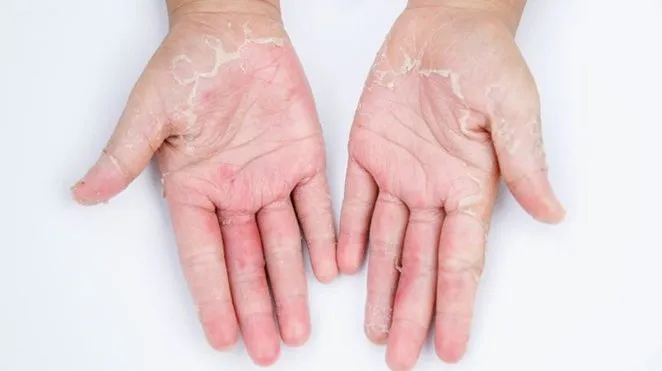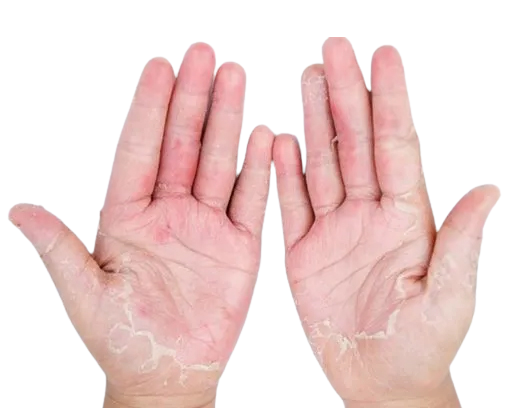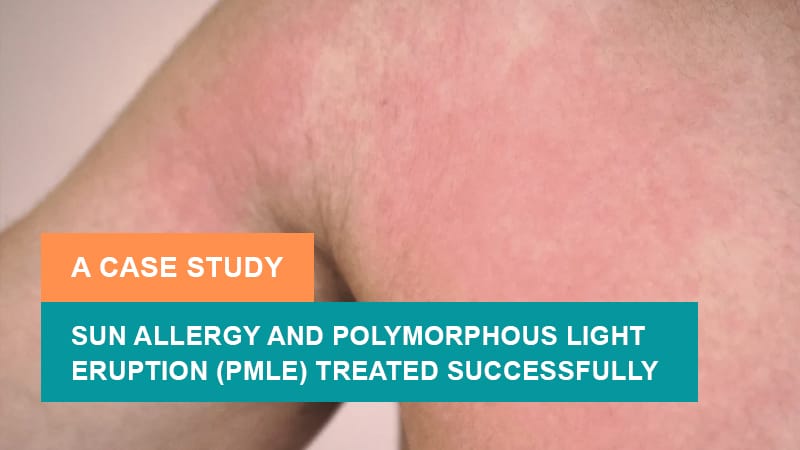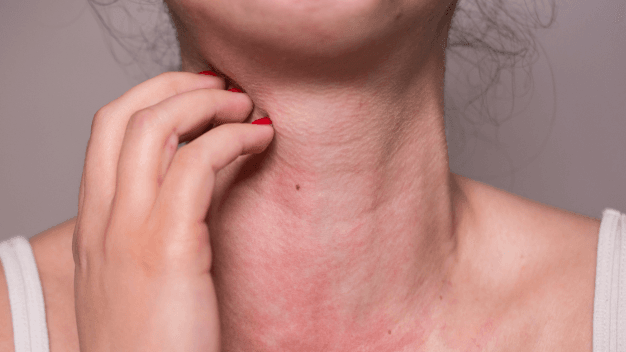On This Page
Introduction
Are you suffering from unexplained skin rashes, itching, or breathing difficulties after touching rubber products? Do you experience allergic reactions when using gloves, balloons, or medical devices? Have you ever wondered why certain fruits like bananas or avocados also trigger allergic symptoms?
If so, you might be dealing with Latex Allergy. This article explores latex allergies, their related allergens, cross-reactions with certain foods, and their symptoms from modern and Ayurvedic perspectives.
Ayurvedic treatment of latex allergy is also described in this topic that deals with it naturally. Additionally, insights from IAFA will help provide a holistic understanding and solutions for those seeking answers to all their questions regarding latex allergies.
What is Latex?
The natural, milky-white liquid that is derived from the rubber tree (Hevea brasiliensis) is known as latex. Latex consists of water, sugar, proteins, resins, and rubber particles, making it highly elastic, and durable and due to this, it serves as the raw material for producing natural rubber.
Latex is widely used in various industries, like in medical & healthcare systems such as gloves, bandages, and syringes. In household items like balloons, rubber bands, mattresses, etc. Latex is also used in the manufacture of sports equipment, tires, etc.
What are the Types of Latex?
There are two main types of latex:-
1. Natural Rubber Latex (NRL):- Natural rubber latex is extracted from rubber trees. This natural latex contains allergenic proteins and in sensitive individuals, they can trigger latex allergies.
2. Synthetic Latex:- Synthetic latex is made from petroleum-based chemicals, it does not contain natural rubber proteins and is used in latex-free gloves, paints, and adhesives.
Some Common Products that Contain Natural Rubber Latex
- Household Items: Household items like rubber gloves used for dishwashing, cleaning, carpet backing, mattress padding, rubber bands, balloons, hot water bottles, adhesive tapes, bandages, rubberized kitchen utensils grips, spatulas, door seals, window seals, waterproof mattress covers, etc.
- School Items: School items like erasers, rubber grips on pens and pencils, rubberized scissors handles, art and craft supplies like rubber stamps, adhesives, glue and paint brush handles, etc.
- Office Items: Office items like rubber bands, mouse pads, adhesive tapes, chair cushions with rubber backing, stamps, stamp pads, electrical cord insulation, etc.
- Sports Items: Sports items like gym mats, yoga mats, resistance bands, sports gloves, tennis racket grips, swimming caps, swimming goggles, shoe soles, football and basketball bladder, bicycle tires and tubes, etc.
- Health and Personal Care Items: Latex gloves (medical, surgical, examination), condoms, diaphragms, catheters, medical tubing, bandages, wound dressings, elastic bandages, braces, toothbrush grips, baby bottle nipples, pacifiers, blood pressure cuffs, stethoscope tubing, sanitary pads with elastic components, etc.
What is Latex Allergy?
The immune system’s reaction to certain proteins found in natural rubber latex (allergens), that are commonly used in gloves, condoms, balloons, medical devices, etc. is known as latex allergies. When an allergic person encounters natural rubber latex, their body perceives it as harmful and triggers mild to severe allergic reactions, which include itching, skin rashes, respiratory issues, and even life-threatening anaphylaxis.
Latex Allergy – As Per Ayurveda
In Ayurveda, latex allergy can be understood as Vitiated (Vikrits) Kapha-Pitta, where an aggravated immune response leads to hypersensitivity. The allergens act as toxic substances (Vishakat Dravya) that disturb blood (Rakta), skin (Twaka), and respiratory system (Pranavaha Strotas). In Ayurveda, symptoms involved in latex allergies can be correlated with Udarda, Shitta Pitta, Swasa roga, and Vicharchika.
Who Gets Affected by Latex Allergy?
Latex allergy primarily affects the healthcare workers who frequently use latex gloves or the individuals who frequently go through surgical procedures like those with spina bifida.
Rubber industry workers are also affected by latex allergies as they are more exposed to latex products. Last but not least individuals with a history of other allergies like hay fever, food allergies, asthma, etc. are also affected by latex allergies due to cross reactivity.
Who is the Culprit Behind Latex Allergy?
Each year approximately 12 million tons of natural rubber latex are produced and utilized in the manufacturing of numerous commercial goods that are used by customers. While some latex-based products have received approval and regulation from government bodies like the FDA, most finished products do not specify whether they contain latex.
Due to the vast number of unidentified latex-containing items and the multiple ways individuals can be exposed to latex and come in contact with latex allergens and latex allergies occur, it proves to be more challenging.
How Common is Latex Allergy?
The data published in the early 21st century have shown that approximately 10 %–17 % of healthcare workers and as much as 73% of patients with spina bifida have been diagnosed with latex allergy.
As per recent survey, the prevalence of latex allergy in the general population is 1- 5%. The prevalence of latex allergy throughout the world remains 9.7%, 7.2%, and 4.3% among healthcare workers, susceptible patients, and the general population, respectively.
As per a survey of health workers, 8- 17% of latex allergy occurs due to latex gloves, and as per the survey, the prevalence of latex sensitivity among the spina bifida pediatric population was between 40% and 65%. Along with this occupational workers, including workers from the rubber industry, housekeepers, and hairdressers are also at high risk of suffering from latex allergy.
As per a recent study, approximately 30%–50% of individuals with latex allergy show an associated hypersensitivity to one or more fruits i.e. latex fruit syndrome.
What are Latex Allergens?
The specific proteins found in natural rubber latex derived from the rubber tree i.e. Hevea brasiliensis are known as latex allergens. These proteins present in natural rubber latex can trigger an immune response in sensitive individuals, leading to latex allergy.
Classification of Latex Allergens
In recent research, several latex allergens have been identified, and each is labeled with a Hev b (Hevea brasiliensis) designation. Approximately 15 latex allergens are there that lead to latex allergies i.e. Hev b 1 to Hev b 15 These allergens belong to different protein families and contribute to various allergic reactions in individuals.
1. Major Latex Allergens – Highly Allergenic Proteins
The most common proteins involved in latex allergy reactions are as follows:
- Hev b 1: This protein is responsible for the rubber elongation factor and is considered a major allergen in children with spina bifida.
- Hev b 3: Hev b 3 is a small rubber particle protein that is involved in IgE-mediated allergic reactions in sensitive individuals who come in contact with latex.
- Hev b 5: This protein plays a role in severe latex allergic reactions and is considered a major allergen in healthcare workers.
- Hev b 6: highly allergenic proteins in latex, including pro-hevein and hevein.
2. Minor Latex Allergens
These protein allergens are less common but still reactive in some individuals and are considered a cause of latex allergy.
- Hev b 9 & Hev b 10: The enzymes involved in rubber metabolism are Hev b 9 & Hev b 10.
- Hev b 2: It is Beta- 1, 3- glucanase, found in rubber tree sap.
- Hev b 4: This is involved in the latex biosynthesis process.
- Hev b 7: Protein with cross-reactivity to certain food allergens.
- Hev b 8: This is involved in cross-reactivity with certain fruits and therefore involved in latex-fruit syndrome.
How are the Individuals Exposed to Latex Allergens?
- By direct skin contact
- By airborne latex exposure
- Latex contamination in food
- Latex contamination in medicine
- Cross-reactivity with fruit
What is Latex-Fruit Syndrome?
Some latex proteins have structural similarities with proteins found in certain fruits, vegetables, and pollen, leading to latex-fruit syndrome. When individuals are allergic to natural rubber latex, they also experience allergic reactions to certain fruits and vegetables which is known as latex fruit syndrome.
This occurs due to cross-reactivity between latex proteins and proteins present in specific plant-based foods. The immune system of the individual mistakenly identifies similar proteins in these foods as allergens and triggers allergic symptoms.
In Ayurveda, latex-fruit syndrome can be correlated with incompatibility (Asatmyata), indigestion (Ajeerna), skin disorders (Twak Vikara), and toxic reactions (Visha Dravya) due to imbalance of Kapha, Pitta Dosha and blood vitiation (Rakta Dushti)
What are the Common Cross-Reactive Foods with Latex Proteins?
Bananas, avocado, chestnut, celery, melon, potato, papaya, fig, tomato, kiwi, jackfruit, etc. are the most common cross-reactive foods. However, they are also classified as follows:-
- Foods with high latex proteins: Kiwi, avocado, banana, chestnut, etc.
- Foods with moderate latex proteins: Apple, tomato, celery, melon, carrot, papaya, potato, etc.
- Foods with low latex proteins: Buckwheat, pineapple, sunflower seeds, citrus, cherry, apricot, coconut, fig, watermelon, hazelnut, lychee, mango, peach, pear, grape, persimmon, plum, shellfish, soybean, strawberry, zucchini, etc.
What are the Causes of Latex-Fruit Syndrome?
- Cross-reaction between proteins: Latex contains proteins that act as allergens like Hev b 6 i.e. hevein and Hev b 8 i.e. profilin, which share structural similarities with proteins present in some fruits.
- Immune hypersensitivity: The body’s immune system overreacts to proteins present in certain fruits due to structural similarities with latex proteins, leading to allergic symptoms.
- Pre-existing latex allergy: People with latex allergies and individuals who are sensitive to allergies are at a higher risk of developing latex-fruit syndrome.
What Symptoms Do We Find in Latex-Fruit Syndrome?
Symptoms may be mild to severe like mild. Symptoms found in individuals are itching, swelling of lips, swelling of the tongue, tingling sensation in the mouth, etc. Moderate Symptoms in LFS (Latex-fruit syndrome) are urticaria), nausea, abdominal pain, etc. In severe cases, symptoms like difficulty in breathing, lowering blood pressure, and life-threatening reactions can be seen.
Types of Latex Allergies
Type – I Hypersensitivity (IgE-Mediated Latex Allergy)
When against latex protein, an immediate allergic reaction is produced by the immune system then it is known as Type- I hypersensitivity. The symptoms of this type of allergy range from mild like itching, hives, etc. to severe reactions like respiratory distress. This type of latex allergy is very common in rubber industry workers, health care workers, etc.
Type IV Hypersensitivity (Cell-Mediated Contact Dermatitis)
This type of latex allergy occurs as a result of delayed allergic reactions caused by chemicals like accelerators and antioxidants used in latex manufacturing. Its symptoms after exposure typically appear between 24-48 hours after and include symptoms like itching, dryness, redness, and cracking of the skin. This type of allergy may become chronic with repeated exposure, but it is not life-threatening.
Irritant Contact Dermatitis
Due to repeated exposure to latex products without an immune response, this is the most common and least severe reaction in which symptoms like dry, itchy, and irritated skin appear and are often associated with prolonged glove use, sweating, and repeated friction. It generally does not involve the immune system and usually resolves with proper skin care and the use of barrier protection.
Causes of Latex Allergy
- Repeated exposure to latex products like balloons, gloves, and medical devices.
- Protein content of natural rubber latex.
- Individuals allergic to certain foods like kiwi, banana, etc. may develop latex allergies due to certain proteins.
- Airborne particles are produced by latex gloves that can be inhaled and lead to latex allergy.
- Genetic predisposition
- Immunocompromised individuals
- Working in the rubber industry
- Individuals frequently use latex products.
Causes of Latex Allergy – As Per Ayurveda
- Latex is the secretion of the plant that acts as toxic for certain individuals as it affects their plasma (Rasa) and blood (Rakta) which leads to hypersensitivity due to the vitality of bodily tissue (Dhatu Dushti)
- An improper lifestyle and diet lead to an imbalance of blood (Dushita Rakta) which makes the body prone to allergic reactions.
- Imbalanced digestive fire (Agni Vaishmya) leads to toxin (Ama) formation which increases sensitivity to allergens.
- Vata and Pitta Parkopa.
- An incompatible diet may trigger immune hypersensitivity.
Symptoms of Latex Allergy
- Various skin reactions like redness, rash, itching, hives, etc.
- When latex touches the skin, the skin becomes dry, scaly, and irritated.
- Runny nose
- Swelling of lips. Itchy and watery eyes.
- Throat irritation
- Cough
- Chest tightness
- Difficulty in breathing
- Severe drop in blood pressure
- Fainting
- Nausea
- Vomiting
- Abdominal cramps
Symptoms of Latex Allergy – As Per Ayurveda
- Itching (Kandu)
- Burning sensation (Toda)
- Pustule or rashes formation (Pidika)
- Swelling in affected areas (Shotha)
- Cough (Kasa)
- Breathing difficulty (Shwasa)
- Sneezing, runny nose (Pratishaya)
- Throat swelling (Kantha Sotha)
- Excessive sweating (Ayartha Swedana)
- Palpitation (Hrid Drava)
- Dizziness (Bhrama)
- Fainting (Murcha)
- Fever (Jwara)
- Abdominal cramps (Udara Shula)
Ayurvedic Reference of Latex Allergy – Udarda

Diagnosis of Latex Allergy – As Per Ayurveda
In Ayurveda, the diagnosis of latex allergy is based on Nidana Panchaka and threefold examination (Trividha Pareeksha). It is primarily a Pitta-Vata-Rakta Dushti, manifesting as skin disorders (Twaka Vikara) and respiratory issues (Pranavaha Srotas Dushti).
Causative factors (Nidana) include repeated latex exposure, Pitta-aggravating foods, and improper lifestyle. Premonitory symptoms i.e. Poorva Rupa, include itching, burning, and mild breathlessness, while manifest symptoms (Rupa) as rashes, swelling, itching and wheezing, etc.
Diagnosis is confirmed through Trividha Pareeksha i.e. visual examination (Darshana) for skin reactions, palpation (Sparshana) for warmth and swelling, and questioning (Prashana) to assess exposure history, relief- aggravating factors.

“Ayurveda assures complete cure in the management of Latex allergies. Dr. Gupta’s IAFA is the perfect destination for Ayurvedic latex allergy treatment as well as all other allergy treatments with high success rates”.
Visit us now and get the rejuvenation!!!
– Dr. Sahil Gupta (B.A.M.S., M.H.A.)
Ayurvedic Allergy Specialist
CEO & Founder of IAFA®
At last, Easier Latex Allergy Management

Trusted by
More than 90,000 Patients

Convenient
at-Home Treatments

9.2 / 10
Customer Satisfaction Score
Ayurvedic Treatment for Latex Allergy
Are you suffering from rashes, swelling, itching, sneezing, or breathing difficulties after coming into contact with latex? Don’t worry! Ayurveda has a solution.
According to Ayurveda, Latex allergy is due to Pitta, Vata, and Rakta Dushti, leading to skin disorders (Tavaka Vikara) and respiratory issues (Pranavaha Srotas Dushti), etc.
Ayurvedic Treatment for Latex Allergy focuses on Pitta and Rakta Shodhana (blood purification) through therapeutic purgation therapy (Virechana) and bloodletting therapy (Rakta Mokshana).
Along with this various herbs are used that help in detoxification and boosting immunity. A wholesome diet, avoiding Pitta-aggravating foods, and using cooling herbal paste (Lepa) can provide relief. The Ayurvedic approach that is used to treat latex allergy is as follows:-
Detoxification Therapy (Shodhana Therapy) for Latex Allergy
1) Purgation Therapy (Virechana) – Therapeutic purgation is done in latex allergy patients with the help of various herbs to remove Pitta toxins from the body and to purify the vitiated blood tissue (Rakta Dhatu). This helps in the overall improvement of skin health, and reduces hypersensitivity, burning sensation, redness, inflammation, etc.
2) Bloodletting Therapy (Rakta Mokshana) – With the use of various techniques like leech therapy (Jalaukavacharana), the removal of impure blood is done from the body in bloodletting therapy. This therapy removes vitiated blood and reduces allergic symptoms like rashes, hives, burning sensations, etc. Recent research shows that this therapy reduces inflammatory mediators in allergic reactions.
3) Nasal Therapy / Intra Nasal Instillation (Nasya) – Medicated oil or powder is administered through the nostril. This nasal therapy helps in clearing nasal passage, strengthens immunity, and reduces various latex allergy symptoms like rhinitis, sneezing, etc., and also helps to improve lung function.
4) Medicated Buttermilk Therapy (Takra Dhara) – In this therapy, continuous medicated buttermilk (Takra) is poured over the head for a certain period. It helps in improving immunity by modulating the overactive response of the immune system, pacifying aggravated Pitta, soothing itchy skin, calming inflammation, etc.
Herbs for Latex Allergy
Herbs for Latex Allergy Ayurvedic Treatment includes Haridra (Curcuma longa), Shirisha (Albizia lebbeck), Neem (Azadirachta indica), Guduchi (Tinospora cordifolia), Yashti Madhu (Glycyrrhiza glabra), Khadir (Acacia catechu), Karanja (Pongamia pinata), Amalaki (Emblica officinalis), etc.
These herbs possess active ingredients like curcumin, tinosporin, nimbidin, flavonoids, glycyrrhizin, etc due to which they exhibit anti-allergic, antioxidant, anti-inflammatory, immunomodulatory, blood purifying, corticosteroid-like action, etc. which helps in reducing allergic skin conditions, reduce hypersensitivity by inhibiting histamine release, etc. which makes them ideal drugs for treating latex allergy.
Gem Therapy for Latex Allergy
Few stones are recommended to wear in Latex Allergy as per Vedic Astrology. These stones can be worn after proper consultation with an astrologer as per your birth date, Zodiac sign, etc. to get only benefits.
As per astrology Emerald (Panna), Pearl (Mukta), and Yellow Sapphire (Pukhraj) can be worn as per your natal chart if you are suffering from latex allergy. These stones help in reducing allergies, and hypersensitivity, relieving skin irritation, balancing Vata, calming the mind, improving immunity, etc.
Diet and Lifestyle Guidance (Pathya-Apathya) for Latex Allergy
According to Ayurveda, if your diet is correct then medicine is of no use because a good gut is considered as the basis of a healthy individual. So, by giving attention to our daily diet, we not only get relief from the diseases from which we suffer but also avoid the upcoming diseases. Below we mention some dietary and lifestyle guidelines that one can follow for latex allergies:-
What to Do (Pathya) in Latex Allergy?
- Take a detoxifying and cool diet like bottle gourd, barley, wheat, moong dal, ash gourd, bitter gourd, etc.
- Pitta-pacifying food should be added to the diet like apples, grapes, papaya, etc.
- Herbal drinks like Amla juice, Guduchi tea, and Neem juice should be included in the diet.
- Omega-3 rich foods like chia seed, flax seed should be included in diet. Probiotics like fermented food, yogurt must be included in the diet.
- Massage with cool oils like Chandanadi tail, coconut oil, etc.
- Use cotton gloves when handling latex products.
- Use non-latex alternatives like nitrile or vinyl gloves, etc.
- Avoid excessive sun exposure.
- Practice Pranayama and Yoga daily.
- Take approximately 2 liters of water every day.
What to Avoid (Apathya) in Latex Allergy?
- Know the products have natural latex and avoid exposure to the latex.
- Avoid heavy meals (Guru Bhojana)
- Avoid incompatible food (Virrudha Aahara)
- Intake of spicy (Katu), sour (Amla), oily (Snigdha), and salty (Lavana) food should be avoided.
- Irregular sleep should be avoided.
- Avoid stress.
- Avoid wearing tight clothes.
- Avoid triggering foods if sensitive.
- Avoid food that cross-reacts with latex.
- Late-night screen time and overwork should be avoided as it weakens immunity.
Yoga Asanas for Latex Allergy
Yoga Asanas for Latex allergy treatment in Ayurveda includes Cobra pose (Bhujangasana), Cow pose (Gomukhasana), Fish pose (Matsyasana), Deep breathing techniques (Pranayama) like cool breath (Sheetali Pranayama), bellow breathing (Bhastrika Pranayama), Meditation, Chin Mudra, Prithvi Mudra, etc.
These Yogic Asanas, Mudra, and breathing techniques balance Vata and Pitta, strengthen the immune system, reduce inflammation, improve lung capacity, reduce hypersensitivity, skin dryness and irritation, etc.

Frequently Asked Questions
Question: How to Treat Latex Allergy Rash?
Answer: To treat latex allergy rash, wash the affected area with mild soap and cool water to remove any latex residue. Apply cool compresses over the affected area to reduce itching and swelling. Topical calamine lotion or antihistamines can help soothe irritation and itching in the affected area. In Ayurveda, applying neem, aloe vera, or turmeric (Haridra) paste can help in healing.
Question: How to Treat Latex Allergic Reaction Naturally?
Answer: Natural treatment for latex allergy focuses on reducing inflammation and strengthening immunity. Herbs like Guduchi (Tinospora cordifolia), Haridra (Curcuma longa), and Neem act as anti-inflammatory agents. Along with this intake of Amla juice and Triphala decoction helps detoxify the body. Externally coconut oil or aloe vera gel can be applied to soothe the skin. Practicing Pranayama (breathing exercises) such as Sheetali and Bhastrika can help manage respiratory reactions.
Question: How to Get Rid of Latex Allergies?
Answer: Latex allergy is a chronic condition that requires long-term management, and the best approach is complete avoidance of latex-containing products. Strengthening the immune system through detoxification therapies (Panchakarma), a Pitta-balancing diet, and stress reduction techniques can help reduce sensitivity to latex. Natural antihistamines like quercetin-rich foods like onions, apples, green tea, and Vitamin C can lower allergic responses.
Question: How Do You Treat Allergic Reactions to Condoms?
Answer: If you experience an allergic reaction to latex condoms, switch to latex-free alternatives such as lambskin, polyurethane, polyisoprene condoms, etc. For immediate relief, rinse the affected area with cool water, apply coconut oil or aloe vera gel, etc.
Question: Which Cream is Best for Latex Allergies?
Answer: For mild reactions, neem oil, aloe vera gel, turmeric paste, or sandalwood paste is effective. In severe cases, consult a doctor. For personalized treatment contact the IAFA team.
References
- Nucera E, Aruanno A, Rizzi A, Centrone M. Latex Allergy: Current Status and Future Perspectives. J Asthma Allergy. 2020 Sep 28; 13: 385- 398. doi: 10. 2147/ JAA. S242058. PMID: 33061465; PMCID: PMC- 7532063.
- Kurup VP, Barrios CS, Raju R, Johnson BD, Levy MB, Fink JN. Immune response modulation by curcumin in a latex allergy model. Clin Mol Allergy. 2007 Jan 25; 5: 1. doi: 10. 1186/ 1476- 7961- 5- 1. PMID: 17254346; PMCID: PMC- 1796894.
- Losa F, Deidda M, Firinu D, Martino MLD, Barca MP, Giacco SD. Exercise-induced anaphylaxis with an Ayurvedic drug as cofactor: A case report. World J Clin Cases. 2019 Mar 6; 7 (5): 623- 627. doi: 10. 12998/ wjcc. v7. i5. 623. PMID: 30863761; PMCID: PMC- 6406205.
- Schexnaildre D. An Ayurvedic approach to sustaining and pampering the feet of healthcare workers. J Interprof Educ Pract. 2022 Dec; 29: 100576. doi: 10. 1016/ j. xjep. 2022. 100576. Epub 2022 Nov 21. PMID: 36440089; PMCID: PMC- 9676917.
- Wu, Miaozong & McIntosh, James & Liu, Jian. (2016). Current prevalence rate of latex allergy: Why does it remain a problem? Journal of Occupational Health. 58. 10. 1539/Joh. 15- 0275- RA.
- MD, MATHILDE & MD, SYLVIE & PhD, JEROME & MD, AGNES & RN, HELENE & PhD, PIERRE & PhD, DOMINIQUE & QUEIROZ, MATHILDE & COMBET, SYLVIE & BERARD, JEROME & Pouyau, Agnes & GENEST, HELENE & MOURIQUAND, PIERRE & CHASSARD, DOMINIQUE. (2009). Latex allergy in children: Modalities and prevention. Pediatric Anesthesia. 19. 313 – 319. 10. 1111/ j. 1460- 9592. 2009. 02955. x.
- Ebo, Didier & Stevens, Wim. (2002). IgE-mediated natural rubber latex allergy: An update. Acta clinica Belgica. 57. 58-70. 10. 1179/ab. 2002. 015.
- Parisi, Claudio & Kelly, Kevin & Ansotegui, Ignacio & Gonzalez- Diaz, Sandra & bilo, maria beatrice & Cardona, Victòria & Park, Hae- Sim & Braschi, Maria Chiara & Weinmann, Alejandra & Piga, Mario Andrea & Acuna- Ortega, Natalhie & Sánchez- Borges, Mario & Yanez, Anahi. (2021). Update on latex allergy: New insights into an old problem. World Allergy Organization Journal. 14. 10. 1016/ j. waojou. 2021. 100569.
- Deval, Ravi & Ramesh, V. & Prasad, GBKS & Jain, Arun. (2008). Natural rubber latex allergy. Indian journal of dermatology, venereology, and leprology. 74. 304- 10. 10. 4103/ 0378- 6323. 42885.
- Binkley, Helen & Schroyer, Traci & Catalfano, Jennifer. (2003). Latex Allergies: A Review of Recognition, Evaluation, Management, Prevention, Education, and Alternative Product Use. Journal of athletic training. 38. 133- 40.
- Gawchik SM. Latex allergy. Mt Sinai J Med. 2011 Sep- Oct; 78 (5): 759- 772. Doi: 10. 1002/msg. 20281. PMID: 219- 13204.
- Kam, Peter & Lee, M. & Thompson, John. (1997). Latex allergy: An emerging clinical and occupational health problem. Anesthesia. 52. 570- 5. 10. 1111/ j. 1365-2222. 1997. 118- az0114. x.
Seek Expert Advice for Latex Allergy – Dr. Sahil Gupta at IAFA Allergy
If you are struggling with latex allergy, experiencing itching, swelling, skin rashes, breathing issues, or frequent allergic reactions, it’s time to seek expert Ayurvedic guidance.
Dr. Sahil Gupta at IAFA specializes in Ayurvedic treatments, offering personalized therapies, dietary recommendations, and lifestyle modifications to help you manage and overcome your latex allergy naturally.
Through detoxification, therapy (Panchkarma), use of herbs, immune-boosting personalized diets, lifestyle modification, etc. you can achieve long-term relief without side effects from the latex allergy.
Book Your Consultation Today with IAFA and Take the First Step Towards Allergy-Free Life with Ayurveda!
Was this Page Helpful?
So IAFA Root-Cause Treatment of Your Latex Allergy is Just 3 Steps Away!

01. Connect With Us
Share your history of illness or Book your appointment

02. Consult With Us
Dr. Gupta a certified Ayurvedic Allergist Consultant

03. Root Cause Treatment
Get an accurate diagnosis, medicines, diet & lifestyle change
Latex Allergy – Case Studies
Real Case Studies of Successfully Treated Patients from All Around the World by IAFA Ayurveda®

9 Year Old Female Patient Recovered from Chronic Allergic Bronchitis – A Case Study
This case study presents a 9-year-old female patient who has successfully recovered…

12-Year-Old Child Recovered from Sun Allergy and Polymorphous Light Eruption (PMLE) – A Case Study
This is a case study of a 12-year-old child who has successfully…

40-Year-Old Female Patient Recovered from Dyshidrotic Eczema and Onychomycosis – A Case Study
This case study highlights the successful recovery of a 40-year-old female patient…

40-Year-Old Female Patient Recovered from Urticaria and Angioedema – A Case Study
This case study focuses on a 40-year-old female patient who has successfully…
Read More Articles

Mast Cell Diseases
Discover Ayurvedic treatment for Mast Cell Diseases, including types, causes, symptoms, and…

High Immunoglobulin-E (IgE) Levels
Discover Ayurvedic treatment for high Immunoglobulin-E (IgE) levels. Learn about the causes,…

Histamine Intolerance
Discover Ayurvedic treatment for histamine intolerance, its causes, symptoms, and natural treatment.…













